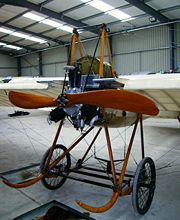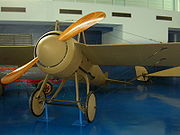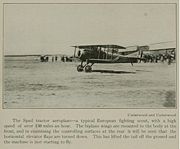
Société Pour L'Aviation et ses Dérivés
Encyclopedia

SPAD S.XIII
|-See also:-Bibliography:* Bruce, J.M. The Aeroplanes of the Royal Flying Corps . London: Putnam, 1982. ISBN 0-370-30084-X.* Sharpe, Michael. Biplanes, Triplanes, and Seaplanes. London: Friedman/Fairfax Books, 2000. ISBN 1-58663-300-7....
biplane was the most popular French fighter airplane in World War I
World War I
World War I , which was predominantly called the World War or the Great War from its occurrence until 1939, and the First World War or World War I thereafter, was a major war centred in Europe that began on 28 July 1914 and lasted until 11 November 1918...
.
Deperdussin

Brussels
Brussels , officially the Brussels Region or Brussels-Capital Region , is the capital of Belgium and the de facto capital of the European Union...
, before making his fortune in the silk
Silk
Silk is a natural protein fiber, some forms of which can be woven into textiles. The best-known type of silk is obtained from the cocoons of the larvae of the mulberry silkworm Bombyx mori reared in captivity...
business. Deperdussin became fascinated by aviation in 1908, and in 1909 he established an aircraft works at Laon
Laon
Laon is the capital city of the Aisne department in Picardy in northern France.-History:The hilly district of Laon, which rises a hundred metres above the otherwise flat Picardy plain, has always held strategic importance...
. Deperdussin himself was not a designer, but he hired the talented engineer Louis Béchereau (1880–1970) as technical director. Béchereau would be responsible for Deperdussin and SPAD aircraft designs thereafter.

Deperdussin Monocoque
- References :*Wayne Biddle - Barons of the Sky: From Early Flight to Strategic Warfare. Johns Hopkins University Press, 2001. ISBN 0801868289.*Émile Auguste Duchêne - Flight Without Formulae: Simple Discussions on the Mechanics of the Aeroplane. Longmans, Green and co., 1914....
and the Deperdussin TT
Deperdussin TT
-References:* The Illustrated Encyclopedia of Aircraft , 1985, Orbis Publishing, Page 1434-See also:...
. Both were mid-wing braced monoplanes, similar to Louis Blériot
Louis Blériot
Louis Charles Joseph Blériot was a French aviator, inventor and engineer. In 1909 he completed the first flight across a large body of water in a heavier-than-air craft, when he crossed the English Channel. For this achievement, he received a prize of £1,000...
's Blériot XI
Blériot XI
The Blériot XI is the aircraft in which, on 25 July 1909, Louis Blériot made the first flight across the English Channel made in a heavier-than-air aircraft . This achievement is one of the most famous accomplishments of the early years of aviation, and not only won Blériot a lasting place in...
, and the Nieuport 4
Nieuport
Nieuport, later Nieuport-Delage, was a French aeroplane company that primarily built racing aircraft before World War I and fighter aircraft during World War I and between the wars.-Beginnings:...
, a layout popular with military and civilian clients in the period before the First World War. The TT was a considerable export success, and 63 were built by the Lebedev company in Russia. The model was purchased in small numbers by foreign clients from Deperdussin, and built at Highgate
Highgate
Highgate is an area of North London on the north-eastern corner of Hampstead Heath.Highgate is one of the most expensive London suburbs in which to live. It has an active conservation body, the Highgate Society, to protect its character....
, England by the British Deperdussin Company, run by D Lawrence Santoni and John Cyril Porte
John Cyril Porte
Lieutenant Commander John Cyril Porte CMG, DSM, Royal Navy was a flying boat pioneer associated with the World War I Seaplane Experimental Station at Felixstowe.-Biography:...
. From 1911 Deperdussin was producing his aircraft from a new facility at Grenelle
Grenelle
Grenelle is a neighbourhood in southwestern Paris, France. It is a part of the 15th arrondissement of the city.The area takes it name from Latin Garanella, meaning a wooded area where rabbits live...
, in the Paris suburbs.

Le Havre
Le Havre is a city in the Seine-Maritime department of the Haute-Normandie region in France. It is situated in north-western France, on the right bank of the mouth of the river Seine on the English Channel. Le Havre is the most populous commune in the Haute-Normandie region, although the total...
and Juvisy to build motor boats and waterplanes. The first Schneider Trophy
Schneider Trophy
The Coupe d'Aviation Maritime Jacques Schneider was a prize competition for seaplanes. Announced by Jacques Schneider, a financier, balloonist and aircraft enthusiast, in 1911, it offered a prize of roughly £1,000. The race was held eleven times between 1913 and 1931...
competition was run on 16 April 1913, at Monaco
Monaco
Monaco , officially the Principality of Monaco , is a sovereign city state on the French Riviera. It is bordered on three sides by its neighbour, France, and its centre is about from Italy. Its area is with a population of 35,986 as of 2011 and is the most densely populated country in the...
and won by a Deperdussin floatplane at an average speed of 45.75 mph (about 73 km/h). Deperdussin "Monocoques" won the 1912 and 1913 Gordon Bennett Trophy races, set several world speed records and were the first airplanes to exceed 200 km/h (124.3 mph).
In 1913, Armand Deperdussin was arrested on charges of fraud. He had developed expensive tastes, and, in addition to funding competitions such as the Gordon Bennett Cup
Gordon Bennett Cup
There were three Gordon Bennett Cups, all established by James Gordon Bennett, Jr.*Gordon Bennett Cup in auto racing*Gordon Bennett Cup in ballooning — for a time, a separate cup was also awarded for powered air racing...
, he entertained lavishly. The trading arm of the Comptoir Industrial et Colonial claimed that he funded this by fraudulently borrowing from them using forged receipts from his silk business as security. He remained incarcerated until he was brought to trial in 1917. Although it was claimed that he used much of the money to develop France's aviation expertise, he was convicted and sentenced to five years in prison, but as a concession for first offenders he was reprieved ("sursis") and released immediately. Deperdussin never recovered from the incident and committed suicide in 1924.
Béchereau
After Armand Deperdussin's bankruptcy in 1913 the company went into administration and the name was changed to Société Provisoire des Aéroplanes Deperdussin. With Deperdussin's disgrace the cash flow stopped and the future of the SPAD company was endangered. A consortium led by Louis BlériotLouis Blériot
Louis Charles Joseph Blériot was a French aviator, inventor and engineer. In 1909 he completed the first flight across a large body of water in a heavier-than-air craft, when he crossed the English Channel. For this achievement, he received a prize of £1,000...
bought up the company's assets in 1913 and appointed Béchereau to run the business. The new entity, known as the Société Pour L'Aviation et ses Dérivés, was better known as SPAD.
The first Béchereau-SPAD designs were unusual two-seat biplanes which attempted to provide a forward-firing machine gun in a tractor configuration
Tractor configuration
thumb|right|[[Evektor-Aerotechnik|Aerotechnik EV97A Eurostar]], a tractor configuration aircraft, being pulled into position by its pilot for refuelling....
aircraft. The pilot sat behind the airscrew, as in a tractor design, but the gunner was seated in a nacelle, or pulpit
Pulpit
Pulpit is a speakers' stand in a church. In many Christian churches, there are two speakers' stands at the front of the church. Typically, the one on the left is called the pulpit...
, in front of the propeller, attached to the landing gear. These designs, the SPAD A-series of models A.1, A.2 A.3, and A.4, were built in very small numbers, around sixty each for French and Russian air forces, and were neither popular nor successful. The subsequent development of an effective interrupter gear rendered the unusual configuration unnecessary.
Other early Béchereau designs were generally unsuccessful. The SE, a large twin-engine biplane bomber, performed well on trials, but it was not ordered due to the greater promise of Béchereau's next design.

SPAD S.VII
The SPAD S.VII was the first of a series of highly successful biplane fighter aircraft produced by Société Pour L'Aviation et ses Dérivés during the First World War. Like its successors, the S.VII was renowned as a sturdy and rugged aircraft with good climbing and diving characteristics...
, which superficially resembled a smaller, neater A.2 - without the forward gunner's nacelle. Developed from the SPAD V, of which 268 were ordered but none certainly built as SPAD Vs, the SPAD S.VII was a single-seat tractor biplane fighter of simple and robust design powered by the new Hispano-Suiza
Hispano-Suiza
Hispano-Suiza was a Spanish automotive and engineering firm, best known for its luxury cars and aviation engines in the pre-World War II period of the twentieth century. In 1923, its French subsidiary became a semi-autonomous partnership with the parent company and is now part of the French SAFRAN...
water-cooled V-8
Hispano-Suiza 8
The Hispano-Suiza 8 was a water-cooled V8 SOHC aero engine introduced by Hispano-Suiza in 1914 and used by a number of Allied aircraft during the First World War...
engine. Compared to earlier fighters, when the SPAD VII appeared in 1916, it seemed a heavy and unmanoeuvrable aircraft, but pilots soon learned to take advantage of its speed and strength. Some 3,500 SPAD S.VIIs were built in France during the First World War, 120 in Britain, and 100 in Russia, although far more had been ordered from a new factory in Yaroslavl
Yaroslavl
Yaroslavl is a city and the administrative center of Yaroslavl Oblast, Russia, located northeast of Moscow. The historical part of the city, a World Heritage Site, is located at the confluence of the Volga and the Kotorosl Rivers. It is one of the Golden Ring cities, a group of historic cities...
which was not completed until after the Russian Civil War
Russian Civil War
The Russian Civil War was a multi-party war that occurred within the former Russian Empire after the Russian provisional government collapsed to the Soviets, under the domination of the Bolshevik party. Soviet forces first assumed power in Petrograd The Russian Civil War (1917–1923) was a...
.
Béchereau's subsequent designs until 1918 followed the basic outline of the SPAD S.VII. The two-seaters, the SPAD XI and SPAD XVI, were built in moderate numbers, around 1,000 of each type, but two-seater SPADs were much less successful than the rival Breguet 14
Breguet 14
-See also:-References:*Tomasz J. Kowalski, Samolot Breguet 14, TBiU no.197, Warsaw 2002, ISBN 83-11-09461-6...
(5,500 built) and Salmson 2
Salmson 2
|-References:* Davilla, James J., & Soltan, Arthur M., French Aircraft of the First World War. Stratford, Connecticut: Flying Machines Press, 1997. ISBN 0-9637110-4-0...
(3,200 built). Single-seat developments of the SPAD 7 were more successful. The SPAD XII was a minor variant, the first to use the geared output Hispano-Suiza V-8 engine, which allowed it to be armed with a 37 mm Hotchkiss
Hotchkiss et Cie
Société Anonyme des Anciens Etablissements Hotchkiss et Cie was a French arms and car company established by United States engineer Benjamin B. Hotchkiss, who was born in Watertown, Connecticut. He moved to France and set up a factory, first at Viviez near Rodez in 1867, then at Saint-Denis near...
cannon (moteur-canon) firing through the propeller hub. Tested successfully by ace Georges Guynemer
Georges Guynemer
Georges Guynemer was a top fighter ace for France during World War I, and a French national hero at the time of his death.-Early life and military career:...
, the general conclusion on the SPAD XII is that only very skillful pilots could exploit its powerful armament. Accordingly, although 300 were ordered, most were completed as normal SPAD fighters, with possibly one or two of the SPAD XII aircraft even serving with the US Air Service in France.
The SPAD S.XIII
SPAD S.XIII
|-See also:-Bibliography:* Bruce, J.M. The Aeroplanes of the Royal Flying Corps . London: Putnam, 1982. ISBN 0-370-30084-X.* Sharpe, Michael. Biplanes, Triplanes, and Seaplanes. London: Friedman/Fairfax Books, 2000. ISBN 1-58663-300-7....
was essentially the SPAD S.VII redesigned around a more powerful, geared drive Hispano-Suiza engine, as was used on the SPAD XII. This was produced in even greater numbers, the exact total is uncertain with figures from 7,300 to 8,472 being quoted in different sources. Single-seat SPADs were flown by many ace pilots, including Italy's Count Francesco Baracca
Francesco Baracca
Count Francesco Baracca was Italy's top fighter ace of World War I. He was credited with 34 aerial victories.-Before World War I:...
and the United States Army Air Service
United States Army Air Service
The Air Service, United States Army was a forerunner of the United States Air Force during and after World War I. It was established as an independent but temporary wartime branch of the War Department by two executive orders of President Woodrow Wilson: on May 24, 1918, replacing the Aviation...
's Capt. Eddie Rickenbacker
Eddie Rickenbacker
Edward Vernon Rickenbacker was an American fighter ace in World War I and Medal of Honor recipient. He was also a race car driver and automotive designer, a government consultant in military matters and a pioneer in air transportation, particularly as the longtime head of Eastern Air Lines.-Early...
, with 34 and 26 victories respectively. Georges Guynemer was, as has already been noted, highly successful with the SPAD S.XII, as well as the SPAD S.VII and SPAD S.XIII. At the end of the First World War, all 1,152 single-seat fighters on the strength of French front line air units were SPAD 13s. It is reported that nearly 900 SPAD XIII fighters were eventually to end up in American service.
Although SPAD had been successful, and had reaped very large profits, the very high profits in aircraft manufacturing had led to increased competition during the war. In 1916, for example, over 98% of the SPAD fighters built had come from factories owned by SPAD and Blériot. By 1918, with large industrial syndicates competing for contracts, this had fallen to 43%. SPAD designs accounted for around 20% of French aircraft produced during World War One. Louis Blériot's 1913 investment was a very profitable one.
Blériot-SPAD
Post-war the company became Blériot-SPAD. The first of its designs to be known by this name was Bécherau's elegant monocoqueMonocoque
Monocoque is a construction technique that supports structural load by using an object's external skin, as opposed to using an internal frame or truss that is then covered with a non-load-bearing skin or coachwork...
SPAD 20 biplane. First flown in 1918, the SPAD 20 was not delivered until 1920. The return of peace meant orders were small; only 93 were built.
The return of peace also meant that the company had to face the problem of dealing with its liabilities under the excess profits tax
Excess profits tax
In the United States, an excess profits tax is a tax, some say excise tax, on any profit above a certain amount. A predominantly wartime fiscal instrument, the tax was designed primarily to capture wartime profits that exceeded normal peacetime profits....
of 1 July 1916. As modified in 1917, this imposed an 80% tax rate on almost all "excess profits". The calculation and collection of the tax was a controversial issue, and very large amounts were still outstanding as late as 1940, when the German occupation rendered the whole question irrelevant. With the future uncertain, SPAD was fully incorporated into the Blériot organisation in 1921, and the company effectively disappeared, although a number of Blériot types were marked as SPADs.
Aircraft
- Deperdussin MonocoqueDeperdussin Monocoque- References :*Wayne Biddle - Barons of the Sky: From Early Flight to Strategic Warfare. Johns Hopkins University Press, 2001. ISBN 0801868289.*Émile Auguste Duchêne - Flight Without Formulae: Simple Discussions on the Mechanics of the Aeroplane. Longmans, Green and co., 1914....
- Deperdussin TTDeperdussin TT-References:* The Illustrated Encyclopedia of Aircraft , 1985, Orbis Publishing, Page 1434-See also:...
- SPAD A.2
- SPAD S.VIISPAD S.VIIThe SPAD S.VII was the first of a series of highly successful biplane fighter aircraft produced by Société Pour L'Aviation et ses Dérivés during the First World War. Like its successors, the S.VII was renowned as a sturdy and rugged aircraft with good climbing and diving characteristics...
- SPAD S.XISPAD S.XI-References:* Davilla, James J., & Soltan, Arthur M., French Aircraft of the First World War. Stratford, Connecticut: Flying Machines Press, 1997. ISBN 0-9637110-4-0...
- SPAD S.XIISPAD S.XII-See also:-Bibliography:* Bruce, J.M. The Aeroplanes of the Royal Flying Corps . London:Putnam, 1982. ISBN 0 370 30084 x.* Davilla, James J., & Soltan, Arthur M., French Aircraft of the First World War. Stratford, Connecticut: Flying Machines Press, 1997. ISBN 0-9637110-4-0.*Green, William and...
- SPAD S.XIIISPAD S.XIII|-See also:-Bibliography:* Bruce, J.M. The Aeroplanes of the Royal Flying Corps . London: Putnam, 1982. ISBN 0-370-30084-X.* Sharpe, Michael. Biplanes, Triplanes, and Seaplanes. London: Friedman/Fairfax Books, 2000. ISBN 1-58663-300-7....
- SPAD S.XIV
- SPAD S.XXSPAD S.XX|-References:* * -See also:...
- Bleriot-SPAD S.33Blériot-SPAD S.33The Bleriot-SPAD S.33 was a small French airliner developed soon after World War I. A great success, the S.33 dominated its field throughout the 1920s, initially on CMA's Paris-London route, and later on continental routes serviced by Franco-Roumaine...
- Bleriot-SPAD S.34Blériot-SPAD S.34|-References:* Keskinen, Kalevi; Partonen, Kyösti and Stenman, Kari: Suomen Ilmavoimat I 1918-27, 2005. ISBN 952-99432-2-9.* Keskinen, Kalevi; Stenman, Kari and Niska, Klaus: Suomen ilmavoimien lentokoneet 1918-1939, Tietoteos, 1976.-External links:...
- Bleriot-SPAD S.46Blériot-SPAD S.46-See also:...
- Bleriot-SPAD S.51Blériot-SPAD S.51|-References:*...
- Bleriot-SPAD S.56Blériot-SPAD S.56|-References:* -See also:...
- Bleriot-SPAD S.61Blériot-SPAD S.61-See also:...
- Bleriot-SPAD S.66
- Bleriot-SPAD S.81Blériot-SPAD S.81-See also:...
- Bleriot SPAD 111Blériot 111The Blériot 111 was a French four-seat executive transport monoplane designed by André Heremont. The first French aircraft to be fitted with a retractable landing gear, after six years development it was not ordered into production.-Design and development :...
- Bleriot-SPAD S.510

